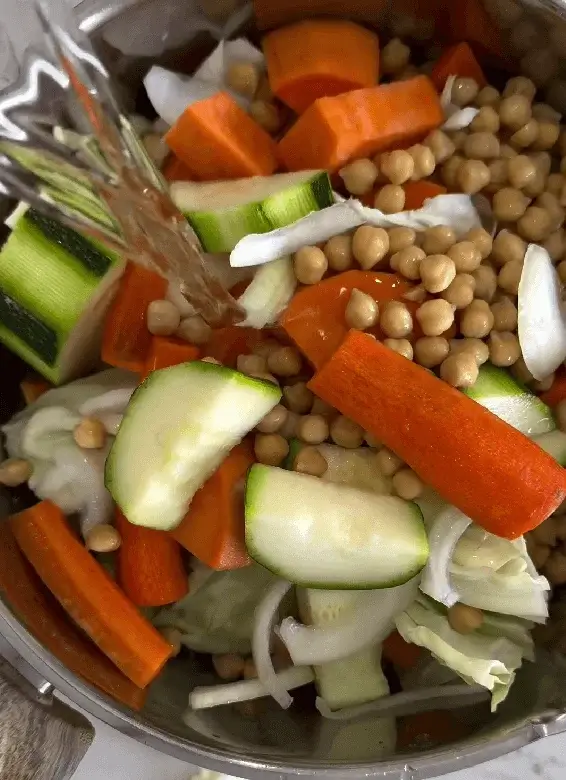How to Make Couscous from Scratch
We may earn a commission from recommended products, at no extra cost to you. See Disclosure.
- Couscous sieve strainer
- Chef knife
INGREDIENTS
Soup:
- 1 sweet potato, thickly sliced
- 2 onions, sliced
- 1 bag frozen chickpeas
- 4-5 medium-sized potatoes, quartered
- 2 zucchinis, thickly sliced
- 1 butternut squash, cut into large chunks
- 1 white cabbage, cut into large chunks
- 4 carrots, peeled and thickly sliced
- 2 tablespoons chicken soup seasoning
- 1 tablespoon turmeric
- 1 tablespoon salt
- ½ tablespoon ground black pepper
- Water to cover
Couscous:
- 2.2 pounds/1 kilogram semolina, sifted
- 1 tablespoon salt
- ½ cup oil
- 3½ cups water
INSTRUCTIONS
Soup:
- Place all the vegetables in a pot, cover them with water, add the spices, and bring to a boil over medium heat.
Couscous:
- Combine the semolina and salt in a large bowl and mix. Gradually add a cup of water while stirring. Stop when the mixture is slightly lumpy. Do not use the entire cup of water; the goal is not to form dough. Once couscous crumbs are formed, add the oil, mix well, and transfer to a couscous sieve strainer.
- Meanwhile, prepare a couscous pot by filling half of it with water and bringing it to a boil. Place the sieve strainer with the couscous in it over the boiling water. Cover the pot and steam for 40 minutes.
- Transfer the couscous to a bowl, pour 2½ cups of water, and cover for 20 minutes.
- Stir and strain the couscous again, and it’s ready.
- Serve the couscous with the vegetables on top and a little bit of the soup.

FAQ
Is couscous a grain or pasta?
Couscous is a dish that often sparks the debate over whether it is a grain or pasta. Originating from North Africa, couscous is traditionally made from crushed and steamed wheat, typically durum wheat. While it shares similarities with pasta, couscous is not produced through the pasta-making process. Instead, it is a type of tiny, granular semolina that is pre-steamed during production, giving it a unique texture. Despite its wheat origin, couscous is often considered a type of pasta due to its preparation method and usage in various cuisines. The debate continues, and the classification may vary based on culinary perspectives.



What do you eat couscous with?
Commonly served alongside Mediterranean and Middle Eastern cuisines, couscous complements savory stews, roasted vegetables, grilled meats, and tagines. It absorbs flavors, making it an ideal accompaniment to curries, salads, or as a bed for fish or chicken. Additionally, couscous can be incorporated into cold salads with fresh herbs and vegetables, providing a light and refreshing option. Its adaptability extends to both vegetarian and non-vegetarian meals, showcasing its ability to enhance various flavors and textures.


How to make couscous from scratch that is super fluffy
Learning how to make couscous from scratch that is super fluffy requires attention to detail. Begin by using fine-quality semolina and ensuring it’s well sifted. When you uncover the couscous after steaming, fluff it gently with a fork to separate the grains. To enhance fluffiness, you can also incorporate a drizzle of olive oil or a knob of butter, ensuring a light and airy texture that elevates your couscous dish.

Why is my couscous rubbery?
When you first learn how to make couscous from scratch, encountering annoyingly rubbery couscous can be a big downer. But don’t worry! You will soon understand why it happens and what you can do to avoid it. Rubberiness in couscous can result from overcooking or inadequate moisture absorption. Overcooking causes the couscous to become dense, losing its light, fluffy texture. Ensure you adhere to the recommended cooking time.
Additionally, insufficient water absorption can lead to rubbery couscous. Always use the correct ratio of liquid to couscous and allow the grains to absorb moisture adequately during the cooking process.

